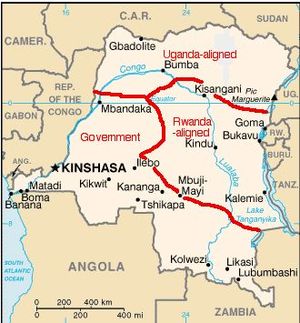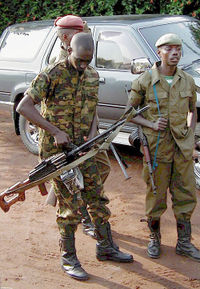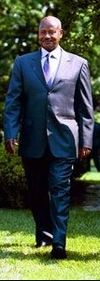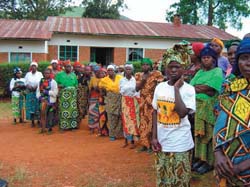Second Congo War
2007 Schools Wikipedia Selection. Related subjects: Military History and War
| Second Congo War | |||||||
|---|---|---|---|---|---|---|---|
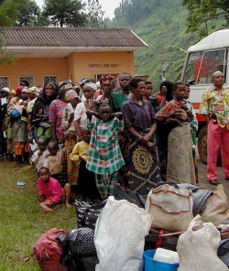 Civilians waiting to cross the DRC-Rwanda border (2001) |
|||||||
|
|||||||
| Combatants | |||||||
Mai-Mai, Hutu-aligned forces |
Tutsi-aligned forces |
||||||
| Commanders | |||||||
| Laurent-Désiré Kabila (Congo), Joseph Kabila (Congo), Padiri (Mai-Mai), Dunia (Mai-Mai) |
Paul Kagame (Rwanda), Yoweri Museveni (Uganda), Ernest Wamba dia Wamba ( RCD) |
||||||
| Strength | |||||||
| Mai-Mai: 20-30,000 militia, Hutu Interahamwe: 20,000+ |
RCD: Unknown, Rwanda: 8,000+ |
||||||
| Casualties | |||||||
| Civilians killed: 3,500,000+ | |||||||
The Second Congo War was a conflict that took place largely in the territory of Democratic Republic of the Congo (formerly Zaire). The war began in 1998 and officially ended in 2003 when a Transitional Government took power. The widest interstate war in modern African history, it directly involved nine African nations, as well as about twenty armed groups, and earned the epithet of "Africa's World War" and the "Great War of Africa." An estimated 3.8 million people died, mostly from starvation and disease brought about by one of the deadliest conflicts since World War II. Millions more were displaced from their homes or sought asylum in neighboring countries.
Despite a formal end to the war in July 2003 and an agreement by the former belligerents to create a government of national unity, the state remains weak and much of the eastern region continues to suffer from violent conflict. In 2004, an estimated one thousand people died every day from violence and disruptions to basic social services and food supply. Sporadic outbreaks of fighting continue to lead to large scale forced migration.
Origin of the Second Congo War
Colonial era
Congo has had a troubled history since it was ruled as a colonial possession until 1908 by King Léopold II of Belgium as the Congo Free State and afterwards by Belgium (see Belgian Congo). Even by the standards of late 19th-century colonialism, the rule by King Léopold II is generally regarded as being arbitrary and brutal. Because of its mineral wealth, and the ongoing effects of the colonial period, Congo has been a state that has had tremendous trouble since transitioning to self-rule in 1960.
Regime of Mobutu
| History of DR Congo |
|
In 1960, a democratic election resulted in the victory of the leftist Patrice Lumumba. This would be the only free election until those held in 2006. Lumumba served as Prime Minister alongside the other top candidate as president. Lumumba was first illegally "fired" by the president, then murdered in the presence of officials of the secessionist province of Katanga in a coup backed by the CIA and Belgium . By 1965, Mobutu had established himself as the dictator of the nation, backed by Western powers intent on arresting the spread of Soviet influence after civil war broke out in Angola. In the early 1990s the economy of Zaire was under tremendous pressure because of the long commodities depression and Mobutu's efforts to retain power. While he advanced the sense of nationalism, he also created a cult of personality and a nation that was described by international agencies as a "basket case" . Mobutu looted the resources of the Congo to increase his personal wealth so shamelessly that the term "Kleptocracy" was essentially invented to describe his rule. In 1991 Mobutu was forced to make concessions to some of the opposition leaders, but the state of finances remained precarious and the army continued to deteriorate. By 1995, his hold on power was tenuous: salaries were not being paid to public officials and members of the army, violence was endemic, and corruption was routine.
With the end of the Cold War, outside powers disengaged from sub-Saharan Africa. They left nations to deal with the after effects of the conflict between the superpowers and colonialism, as well as the internal conflicts between local groups. When the United States withdrew its backing of Mobutu, rebels and rival nations correctly felt that he would be easier to overthrow while deprived of outside support.
The 1994 Rwandan Genocide, and related violence in Burundi, precipitated a crisis in the eastern part of the nation: hundreds of thousands of members of the Hutu ethnic group fled both countries into Zaire in the Great Lakes refugee crisis. The resulting refugee camps quickly became dominated by the Interahamwe Hutu militias that had carried out much of the genocide, supported by Hutu members of the former Rwanda military.
The Rwandans and Ugandans began to funnel weapons and money to the anti-Sese Seko Alliance of Democratic Forces for the Liberation of Congo (ADFLC) under Laurent-Désiré Kabila.
First Congo War
The First Congo War began in 1996 as Rwanda grew increasingly concerned that members of these militias, who were carrying out cross-border raids, were planning an invasion. The new Tutsi-dominated government of Rwanda protested this violation of their territorial integrity and began to give arms to the ethnically Tutsi Banyamulenge of eastern Zaire. This intervention was vigorously denounced by the government of Zaire under dictator Mobutu Sese Seko, but he did not have any military capability to oppose, and little political capital to spend.
Kabila's March to Kinshasa
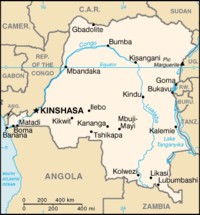
With active support from Rwanda, Uganda and Angola, Kabila's forces moved methodically down the river, encountering only light resistance from the crumbling regime based in Kinshasa. The bulk of his fighters were Tutsis and many were veterans from conflicts in the Lakes region of Africa. Kabila himself had credibility because he had been a longtime political opponent of Mobutu, and was a follower of Patrice Lumumba, the first Prime Minister of the independent Congo who was murdered and overthrown from power by a combination of internal and external forces, to be replaced by the then Lt.-Gen. Mobutu. Kabila had declared himself a Marxist and an admirer of Mao Zedong. He had been waging armed rebellion in eastern Zaire for nearly two decades, though, according to Che Guevara's account of the conflict, he was an uncommitted and uninspirational leader.
Kabila's army began a slow movement westward in December 1996 near the end of the Great Lakes refugee crisis, taking control of border towns and mines and solidifying control. There were reports of massacres and brutal repression by the rebel army. A UN human rights investigator published statements from witnesses claiming that the ADFLC engaged in massacres, and that as many as 60,000 civilians were killed by the advancing army (a claim strenuously denied by the ADFLC). Roberto Garreton stated that his investigation in Goma turned up allegations of disappearances, torture and killings. He quoted Moese Nyarugabo, an aide to Mobutu as saying that killings and disappearances should be expected in wartime.
In March 1997, Kabila's forces launched an offensive, and demanded the government surrender. On March 27th it was reported that the rebels took Kasenga. These reports were dismissed by the government, which would begin a long pattern of false statements from the Defense Minister as to the progress and conduct of the war.
Talks were proposed in late March, and on April 2, a new Prime Minister was installed: Etienne Tshisekedi, a long time rival of Mobutu. Kabila, by this point in rough control of one quarter of the country, dismissed this as irrelevant, and warned Tshisekedi that he would have no part in a new government if he accepted the post.
Throughout the month of April the ADFLC made consistent progress down the river, and by May were on the outskirts of Kinshasa. On May 16, 1997, the multinational army headed by Kabila battled to secure Lubumbashi airport after peace talks broke down and Mobutu fled the country. (He died on September 7, 1997 in Morocco). After securing victory, Kabila controlled Kinshasa. He proclaimed himself President on the same day and immediately ordered a violent crackdown to restore order. He then began an attempt at reorganization of the nation.
Unwelcome "support"
When Kabila took control of the capital in May 1997, he faced substantial obstacles to governing the country that he renamed "the Democratic Republic of Congo" (DRC). Beyond political jostling among various groups to gain power and an enormous external debt, his foreign backers proved unwilling to leave when asked. The conspicuous Rwandan presence in the capital also rankled many Congolese, who were beginning to see Kabila as a pawn of foreign powers.
Tensions reached new heights on 14 July 1998, when Kabila dismissed his Rwandan chief of staff, James Kabare, and replaced him with a native Congolese. Apparently Kabila felt that he had solidified his Congolese political base enough to put some distance between himself and the nations who had put him into power. Although the move chilled what was already a troubled relationship with Rwanda, he softened the blow by making Kabare the military advisor to his successor.
Two weeks later Kabila abandoned such diplomatic steps. He thanked Rwanda for their help, and ordered all Rwandan and Ugandan military forces to leave the country. Within 24 hours Rwandan military advisors living in Kinshasa were unceremoniously flown out. The people most alarmed by this order were the Banyamulenge of eastern Congo. Their tensions with neighboring ethnic groups had been a contributing factor in the genesis of the First Congo War and they were also utilized by Rwanda to affect events across the border in the DRC. The Banyamulenge would again prove to be the spark of another conflagration.
Course of the war
The initial rebel offensive threatened the Kabila government in a matter of weeks. The government was only saved through the rapid intervention of a number of other African states. For a time it looked that, as the rebel forces were forced back, an escalation in the conflict to a conventional war between multiple national armies loomed. Such an outcome was avoided as battle lines stabilized in 1999. Since then the conflict has primarily been fought by irregular proxy forces with little change in the territories held by the various parties.
Rebel push for Kinshasa
On 2 August 1998, the Banyamulenge in the town of Goma erupted into mutiny. Rwanda offered immediate assistance to the Banyamulenge and early in August a well-armed rebel group, the Rally for Congolese Democracy (RCD), composed primarily of Banyamulenge and backed by Rwanda and Uganda had emerged. This group quickly came to dominate the resource-rich eastern provinces and based its operations in the city of Goma. The RCD quickly took control of the towns of Bukavu and Uvira in the Kivus. The Tutsi-led Rwandan government allied with Uganda, and Burundi also retaliated, occupying a portion of northeastern Congo. To help remove the occupying Rwandans, President Kabila enlisted the aid of the Hutu militants in eastern Congo and began to agitate public opinion against the Tutsis, resulting in several public lynchings in the streets of Kinshasa. On 12 August a loyalist army major broadcast a message urging resistance from a radio station in Bunia in eastern Congo: "People must bring a machete, a spear, an arrow, a hoe, spades, rakes, nails, truncheons, electric irons, barbed wire, stones, and the like, in order, dear listeners, to kill the Rwandan Tutsis."
The Rwandan government also claimed a substantial part of eastern Congo as "historically Rwandan". The Rwandans alleged that Kabila was organizing a genocide against their Tutsi brethren in the Kivu region. The degree to which Rwandan intervention was motivated by a desire to protect the Banyamulenge, as opposed to using them as a smokescreen for its own regional aspirations, remains in question.
In a bold move, RCD rebels hijacked a plane and flew it to the government base of Kitona on the Atlantic coast, where other mutinous government soldiers joined them. More towns in the east and around Kitona fell in rapid succession as the combined RCD, Rwandan and Ugandan soldiers overwhelmed the government forces amid a flurry of ineffectual diplomatic efforts by various African nations. By 13 August, less than two weeks after the revolt began, the rebels held the Inga hydroelectric station that provided power to Kinshasa as well as the port of Matadi through which most of the Kinshasa's food passed. The diamond centre of Kisangani fell into rebel hands on 23 August and forces advancing from the east had begun to threaten Kinshasa by late August. Uganda, while retaining joint support of the RCD with Rwanda, also created a rebel group that it supported exclusively, the Movement for the Liberation of Congo (MLC).
Despite the movement of the front lines, fighting continued throughout the country. Even as rebel forces advanced on Kinshasa, government forces continued to battle for control of towns in the east of the country. The Hutu militants with which Kabila was cooperating were also a significant force in the east. Nevertheless, the fall of the capital and Kabila, who had spent the previous weeks desperately seeking support from various African nations and Cuba, seemed increasingly certain.
Kabila gains regional support
The rebel offensive was abruptly reversed as Kabila's efforts at diplomacy bore fruit. The first to respond were fellow members of the Southern African Development Community (SADC). While officially the SADC members are bound to a mutual defense treaty in the case of outside aggression, many member nations took a neutral stance to the conflict. However, Namibia, Zimbabwe and Angola all quickly threw their support behind the Kabila government after a meeting in the Zimbabwean capital of Harare on 19 August.
- Angola
- Caught up in its own 25-year-old war against UNITA rebels, Angola wished to eliminate the UNITA operation in southern Congo which imported weapons while exporting diamonds out of Angola. This is the same reason it participated in the First Congo War to overthrow the hostile Mobutu government. Angola had no confidence that a new president would be better than Kabila, and feared that continued fighting would lead to a power vacuum that could only help UNITA.
- Zimbabwe
- President Robert Mugabe was the most ardent supporter of intervention on Kabila's behalf, and was lured by Congo's rich natural resources and a desire to increase his own power and prestige in Africa. Kabila and Mugabe had signed a US$200 million contract involving corporations owned by Mugabe and his family, and there were several reports in 1998 of numerous mining contracts being negotiated with companies under the control of the Mugabe family. Mugabe had resented being displaced by South African Nelson Mandela as the premiere statesman of southern Africa and the war was also a chance to confront another prominent African president, Yoweri Museveni of Uganda. As the head of the SADC's Organ on Politics, Defence and Security Mugabe believed he could reclaim his position as southern Africa's premiere statesmen by aiding Kabila.
- Namibia
- President Sam Nujoma had interests in Congo similar to that of Mugabe, with several family members deeply involved in Congolese mining. Namibia itself has little issues of natural interest at stake in the DRC and the Namibian intervention was greeted with dismay and outrage by citizens and opposition politicians.
Several more nations joined the conflict for Kabila in the following weeks:
- Chad
- Kabila had originally discounted the possibility of support from Francophone Africa but after a summit meeting in Libreville, Gabon on 24 September, Chad agreed to send one thousand troops. France had encouraged Chad to join as a means of regaining influence in a region where the French had retreated in disgrace after the 1994 Rwandan genocide.
- Libya
- The government of Muammar al-Qaddafi provided the planes transporting the soldiers from Chad. Qaddafi may have seen a way to profit financially, but is also likely to have been strongly influenced by a desire to break out the international isolation imposed on him by the United States after the 1988 Pan Am Flight 103 bombing over Lockerbie, Scotland.
- Sudan
- Unconfirmed reports in September indicated that Sudanese government forces were fighting rebels in Orientale province close to the Sudanese and Ugandan borders. However, Sudan did not establish a significant military presence inside the DRC, though it continued to offer extensive support to three Ugandan rebel groups—the Lord's Resistance Army, the Uganda National Rescue Front II and the Allied Democratic Forces—in retaliation for Ugandan support for the Sudan People's Liberation Army.
A multisided war thus began. In September 1998, Zimbabwean forces flown into Kinshasa held off a rebel advance that reached the outskirts of the capital city while Angolan units attacked northward from its borders and eastward from the Angolan territory of Cabinda, against the besieging rebel forces. This intervention by various nations saved the Kabila government, and pushed the rebel front lines away from the capital. However, it was unable to defeat the rebel forces, and the advance threatened to escalate into direct conflict with the national armies of Uganda and Rwanda.
In November 1998 a new Ugandan-backed rebel group, the Movement for the Liberation of Congo was reported in the north of the country. On 6 November, President Paul Kagame admitted for the first time that Rwandan forces were assisting the RCD rebels for security reasons, apparently after a request by Nelson Mandela to advance peace talks. On 18 January 1999, Rwanda, Uganda, Angola, Namibia and Zimbabwe agreed on a ceasefire at a summit at Windhoek, Namibia but the RCD was not invited. Fighting thus continued.
Outside of Africa, most states remained neutral, but urged an end to the violence. Non-African states were extremely reluctant to send troops to the region. A number of Western mining and diamond companies, most notably from the United States, Canada, and Israel, supported the Kabila government in exchange for business deals. These actions attracted substantial criticism from human rights groups.
Lusaka peace agreement
On 5 April 1999, tensions within the RCD about the dominance of the Banyamulenge reached a peak when RCD leader Ernest Wamba dia Wamba moved his base from Goma to Uganda-controlled Kisangani. A further sign of a break occurred when Museveni of Uganda and Kabila signed a ceasefire accord on 18 April in Sirte, Libya following the mediation of Libyan President Muammar Gaddafi, and both the RCD and Rwanda refused to take part. On 16 May, Wamba was ousted as head of the RCD in favour of a pro-Rwanda figure. Seven days later the various factions of the RCD clashed over control of Kisangani. On 8 June rebel factions met to try and create a common front against Kabila. Despite these efforts, the creation by Uganda of the new province of Ituri sparked the ethnic clash of the Ituri conflict, sometimes referred to as a "war within a war".
Nevertheless, the diplomatic circumstances contributed to the first cease-fire of the war. In July 1999, the Lusaka Ceasefire Agreement was signed by the six warring countries (Democratic Republic of Congo, Angola, Namibia, Zimbabwe, Rwanda, and Uganda) and, on 1 August, the MLC. The RCD refused to sign. Under the agreement, forces from all sides, under a Joint Military Commission, would cooperate in tracking, disarming and documenting all armed groups in the Congo, especially those forces identified with the 1994 Rwandan genocide. Few provisions were made to actually disarm the militias.
The United Nations Security Council deployed about 90 liaison personnel in August 1999 to support the cease-fire. However, in the following months all sides accused the others of repeatedly breaking the cease-fire, and it became clear that small incidents could trigger attacks.
The tension between Uganda and Rwanda reached a breaking point in early August as units of the Uganda People’s Defense Force and the Rwandan Patriotic Army clashed in Kisangani. In November, government-controlled television in Kinshasa claimed that Kabila's army had been rebuilt and was now prepared to fulfill its "mission to liberate" the country. Rwandan forces launched a large offensive and approached Kinshasa before being repelled.
By February 24, 2000, the UN authorized a force of 5,537 troops, the United Nations Organization Mission in the Democratic Republic of the Congo (known by the French acronym, MONUC), to monitor the cease-fire. However, fighting continued between rebels and government forces, and between Rwandan and Ugandan forces. Numerous clashes and offensives occurred throughout the country, most notably heavy fighting between Uganda and Rwanda in Kisangani in May and June 2000. On 9 August 2000, a government offensive in Equateur Province was stopped along the Ubangui River near Libenge by MLC forces. Despite the failure of military operations, diplomatic efforts made bilaterally or through the United Nations, African Union and Southern African Development Community failed to make any headway.
Kabila's assassination
In January 2001, Laurent Kabila was assassinated by one of his bodyguards. It is unknown who ordered the killing but most feel Kabila's allies were to blame as they were tired of his duplicity, in particular his failure to implement a detailed timetable for the introduction of a new democratic constitution leading to free and fair elections. Angolan troops were highly visible at Kabila's funeral cortege in Kinshasa. However, the smoothness of the transfer of power has led to questions of Western involvement.
The Washington Post favorably contrasted Joseph Kabila—Western educated and English-speaking—with his father. Here was someone who made diplomats "hope that things have changed", whereas "Laurent Kabila stood as the major impediment to a peaceful settlement of the war launched in August 1998 to unseat him" The Lusaka peace deal "remained unfulfilled largely because he kept staging new offensives while blocking deployment of UN peacekeepers in government-held territory." An analyst from the London-based Economist Intelligence Unit is quoted saying "The only obstruction had been Kabila because the [Lusaka] accord called for the government's democratic transition and that was a threat to his power."
By unanimous vote of the Congolese parliament, his son, Joseph Kabila, was sworn in as president to replace him. This was largely as a result of Robert Mugabe's backing and that fact that most parliamentarians had been handpicked by the elder Kabila. In February, the new president met Rwandan President Paul Kagame in the United States. Rwanda, Uganda, and the rebels agreed to a UN pullout plan. Uganda and Rwanda began pulling troops back from the front line.
In April 2001, a UN panel of experts investigated the illegal exploitation of diamonds, cobalt, coltan, gold and other lucrative resources in the Congo. The report accused Rwanda, Uganda and Zimbabwe of systematically exploiting Congolese resources and recommended the Security Council impose sanctions.
Despite frequent accusations of misdeeds in the Congo, the Rwandan government continued to receive substantially more international aid than went to the vastly larger Congo. Rwandan President Paul Kagame was also still respected internationally for his leadership in ending the Rwandan Genocide and for his efforts to rebuild and reunite Rwanda.
Nominal peace
A number of attempts to end the violence were made, but these were not successful. In 2002 Rwanda's situation began to worsen. Many members of the RCD either gave up fighting or decided to join Kabila's government. Moreover, the Banyamulenge, the backbone of Rwanda's militia forces, became increasingly tired of control from Kigali and the unending conflict. A number of them mutinied, leading to violent clashes between them and Rwandan forces. At the same time the western Congo was becoming increasingly secure under the younger Kabila. International aid was resumed as inflation was brought under control.
The Sun City Agreement was formalized on April 19, 2002. It was a framework for providing the Congo with a unified, multipartite government and democratic elections; however, critics noted that there were no stipulations regarding the unification of the army, which weakened the effectiveness of the agreement. There have been several reported breaches of the Sun City agreement, but it has seen a reduction in the fighting.
On 30 July 2002, Rwanda and the Democratic Republic of Congo signed a peace deal after five days of talks in Pretoria, South Africa. The talks centered on two issues. One was the withdrawal of the estimated 20,000 Rwandan soldiers in the Congo. The other was the rounding up of the ex-Rwandan soldiers and the dismantling of the Hutu extremist militia known as Interahamwe, which took part in Rwanda's 1994 genocide and continues to operate out of eastern Congo. Rwanda had previously refused to withdraw until the Hutu militias were dealt with.
Signed on 6 September 2002, the Luanda Agreement formalized peace between Congo and Uganda. The treaty aimed to get Uganda to withdraw their troops from Bunia and to improve the relationship between the two countries, but implementation proved troublesome. Eleven days later the first Rwandan soldiers were withdrawn from the eastern DRC. On 5 October, Rwanda announced the completion of its withdrawal; MONUC confirmed the departure of over 20,000 Rwandan soldiers.
On 21 October the UN published its Expert Panel's Report of the pillage of natural resources by armed groups. Both Rwanda and Uganda rejected accusations that senior political and military figures were involved in illicit trafficking of plundered resources.
On 17 December 2002, the Congolese parties of the Inter Congolese Dialogue, namely: the national government, the MLC, the RCD, the RCD-ML, the RCD-N, the domestic political opposition, representatives of civil society and the Mai Mai, signed the Global and All-Inclusive Agreement. The Agreement described a plan for transitional governance that should have resulted in legislative and presidential election within two years of its signing and marked the formal end of the Second Congo War.
Transitional government
On 18 July 2003, the Transitional Government came into being as specified in the Global and All-Inclusive Agreement out of the warring parties. The Agreement obliges the parties to carry out a plan to reunify the country, disarm and integrate the warring parties and hold elections. There have been numerous problems, resulting in continued instability in much of the country and a delay in the scheduled national elections from June 2005 to July 2006.
The main cause for the continued weakness of the Transitional Government is the refusal by the former warring parties to give up power to a centralized and neutral national administration. All belligerents maintain administrative and military command-and-control structures separate from that of the Transitional Government. A high level of official corruption siphoning money away from civil servants, soldiers and infrastructure projects causes further instability.
The fragility of the state has allowed continued violence and human rights abuses in the east. There are three significant centers of conflict: North and South Kivu, where a weakened FDLR continues to threaten the populace; Ituri, where MONUC has proved unable to contain the numerous militia and groups driving the Ituri conflict; and northern Katanga, where Mai-Mai created by Laurent Kabila slipped out of the control of Kinshasa.
Factions in the Congo conflict
The many armed groups in the conflict may be divided into four broad categories. Given the fluid nature of the war, there have been numerous exceptions and caveats, and groups within a single category have violently clashed in the past over resources and territory.
- Rwandan Patriotic Front-aligned forces
- Included the national armies of the Tutsi-dominated governments of Rwanda and Burundi, the militia groups created by the ethnic Tutsi Banyamulenge residing in the DRC and the Banyamulenge-dominated Rally for Congolese Democracy (RCD) rebel forces based in Goma. Tutsi-aligned forces inside the DRC are most active in North and South Kivu provinces, and have territory extending westward toward Kinshasa. Goals include protecting the national security of Rwanda and Burundi, defending Tutsis in the DRC, checking the influence of Uganda and exploiting natural resources.
- Extremist Hutu-aligned forces
- Included Rwandan Hutus responsible for the 1994 genocide, Burundian rebels seeking to overthrow the government, Congolese Hutus and affiliated Mai-Mai militias. The major Hutu group currently is the Forces Démocratiques de la Libération du Rwanda (FDLR) operating in the Kivus. Goals include expelling foreign Tutsi forces, ethnic cleansing of the Banyamulenge, overthrowing the governments of Rwanda and Burundi, and gaining control of resources.
- Uganda-aligned forces
- Included Uganda's national army and various Uganda-backed rebel groups, such as the Movement for the Liberation of Congo, in control of much of the northeast and central north of the DRC. Stated goals include protecting the borders of Uganda from invasion by DRC-based armed groups such as the Allied Democratic Forces and People's Redemption Army, which may not exist, and destroying rebel bases in the DRC; Uganda had previously claimed that the Kabila government had failed to take action. The United Nations has named Uganda as one country that illegally extracted natural resources.
- Kinshasa-aligned forces
- Included the Congolese national army, various antiforeigner Mai-Mai groups, and allied nations such as Zimbabwe, Angola, Chad, Sudan and Namibia. They control the east and south of the DRC. The main goal is the creation of a strong state in control of its territory and borders, and thus regaining control of the natural resources.
The ethnic violence between Hutu- and Tutsi-aligned forces has been a driving impetus for much of the conflict, with people on both sides fearing their annihilation as a race. The Kinshasa- and Hutu-aligned forces enjoyed close relations as their interests in expelling the armies and proxy forces of Uganda and Rwanda dovetail. While the Uganda- and Rwanda-aligned forces worked closely together to gain territory at the expense of Kinshasa, competition over access to resources created a fissure in their relationship. There were reports that Uganda permitted Kinshasa to send arms to the Hutu FDLR via territory held by Uganda-backed rebels as Uganda, Kinshasa and the Hutus are all seeking, in varying degrees, to check the influence of Rwanda and its affiliates.
Nature of the conflict
The Congo war has largely been one without large battles or clearly defined front lines. While significant numbers of trained soldiers from national armies have been involved, the rulers of those nations have been extremely loath to risk their forces in open combat. The equipment and training of the national armies represents a major investment for the poor states of the region and losses would be difficult to replace. The vast area of Congo dwarfs the armed groups, so military units have been based around strategically important strongholds such as ports, airfields, mining centers and the few passable roads, rather than guarding strictly defined areas of control.
As a result, the war has largely been fought by loosely organized militia groups. These untrained and undisciplined forces have greatly contributed to the violence of the conflict by frequent looting, rape and ethnic cleansing. It has also made peace far harder to enforce as the militias continue operating despite cease-fires between their patrons. These uncontrolled militias and their government allies have killed many Congolese. Many more have died from disease and starvation brought about by the chaos in the region.
Much of the conflict has focused on gaining control of the abundant natural resources of the Congo. The African Great Lakes states have largely paid their military expenses by extracting minerals, diamonds, and timber from the eastern Congo. These efforts have been directed by officers from the Rwandan and Ugandan armies who have grown wealthy as a result. Over time, the Rwandan national army has become far less interested in hunting down those responsible for the genocide and more concerned with protecting their sphere of control in eastern Congo. The occupying forces have levied high taxes on the local population and confiscated almost all of the livestock and much of the food in the region.
Competition for control of resources between the anti-Kabila forces has also resulted in conflict. In 1999, Ugandan and Rwandan troops clashed in the city of Kisangani. The RCD also split into two factions, greatly weakening the anti-Kabila rebel forces and limiting their operation to the eastern portion of the country. However, the forces loyal to and allied with Kabila were too depleted and exhausted to take advantage of this.
Effects
The conflict has had wide ranging effects. The war has served to destroy the economy of an already-poor region as foreign investors have fled and resources have been devoted to fighting the war. Much of the already scant infrastructure in the Congo has been destroyed. The continuation and escalation of ethnic hatreds that fuelled the Rwandan genocide and quickly spilled over into Congo have made the postcolonial ethnic division of the region even more concrete and intractable.
Rape has been used as a weapon of war throughout the conflict. In October 2004 the human rights group Amnesty International reported that 40,000 cases of rape had been reported over the previous six years, the majority occurring in South Kivu. This is an incomplete count as the humanitarian and international organizations compiling the figures do not have access to much of the conflict area and only women who have reported for treatment are included. The actual number of women raped is thus assumed to be much higher. All armed parties in the conflict are guilty of rape, though the militia and various insurgent groups have been most culpable. Of particular medical concern is the abnormally high proportion of women suffering vaginal fistulae, usually as a result of being gang raped. The endemic nature of rape in the conflict has, beyond the physical and psychological trauma to the individual women, contributed to the spread of sexually transmitted diseases, including HIV, in the region.
Deaths resulting from the war are estimated at 3.8 million from surveys conducted by the International Rescue Committee. The vast majority of these deaths (80%–90%) resulted from easily preventable diseases and malnourishment resulting from the disruption of health service, agriculture and infrastructure, and from refugee displacement. The 2004 IRC report also includes death toll estimates of 3.4 million and 4.4 million, a range resulting from changes in basic assumptions in the model.
Effects within the DRC include the displacement of some 3.4 million people, as well as the impoverishment of hundreds of thousands. The majority of the displaced are from the eastern section of the country. Nearly two million others have been displaced in the neighboring countries of Burundi, Rwanda, Tanzania and Uganda.
The war has also raised questions about sub-Saharan Africa as a whole. The increase in democratization and the end of apartheid in South Africa raised great hope for the region in the post Cold War world. Some saw the prospect of an " African Renaissance." The seemingly unending violence in the Congo has dashed many of these hopes and damaged the reputations of a number of statesmen who were once seen as reformers.
The devastating effects on the economy and social institutions have led to serious impacts on the wildlife of the region. In September 2005, a survey reported by the World Wide Fund for Nature showed that the population of hippopotamuses in Virunga National Park's Lake Edward has plummeted to less than 900 individuals from an estimated 29,000 thirty years previously. The decline is attributed to poaching for meat as well as the teeth, which are used to produce illegal ivory. Additionally, about half of the world's 700 wild mountain gorillas live in the same park.
On December 19, 2005, the United Nations International Court of Justice ruled that the DRC's sovereignty had been violated by Uganda, and that Uganda had looted billions of dollars worth of resources. The DRC government has asked for $10 billion in compensation. On July 30, 2006, first elections were held in DR Congo, after approval of a new constitution with democracy. A second round of election was held on October 30, 2006.
Glossary of armed groups
| Militias | Armies | Others | ||
|
|
Political Parties
United Nations
|

